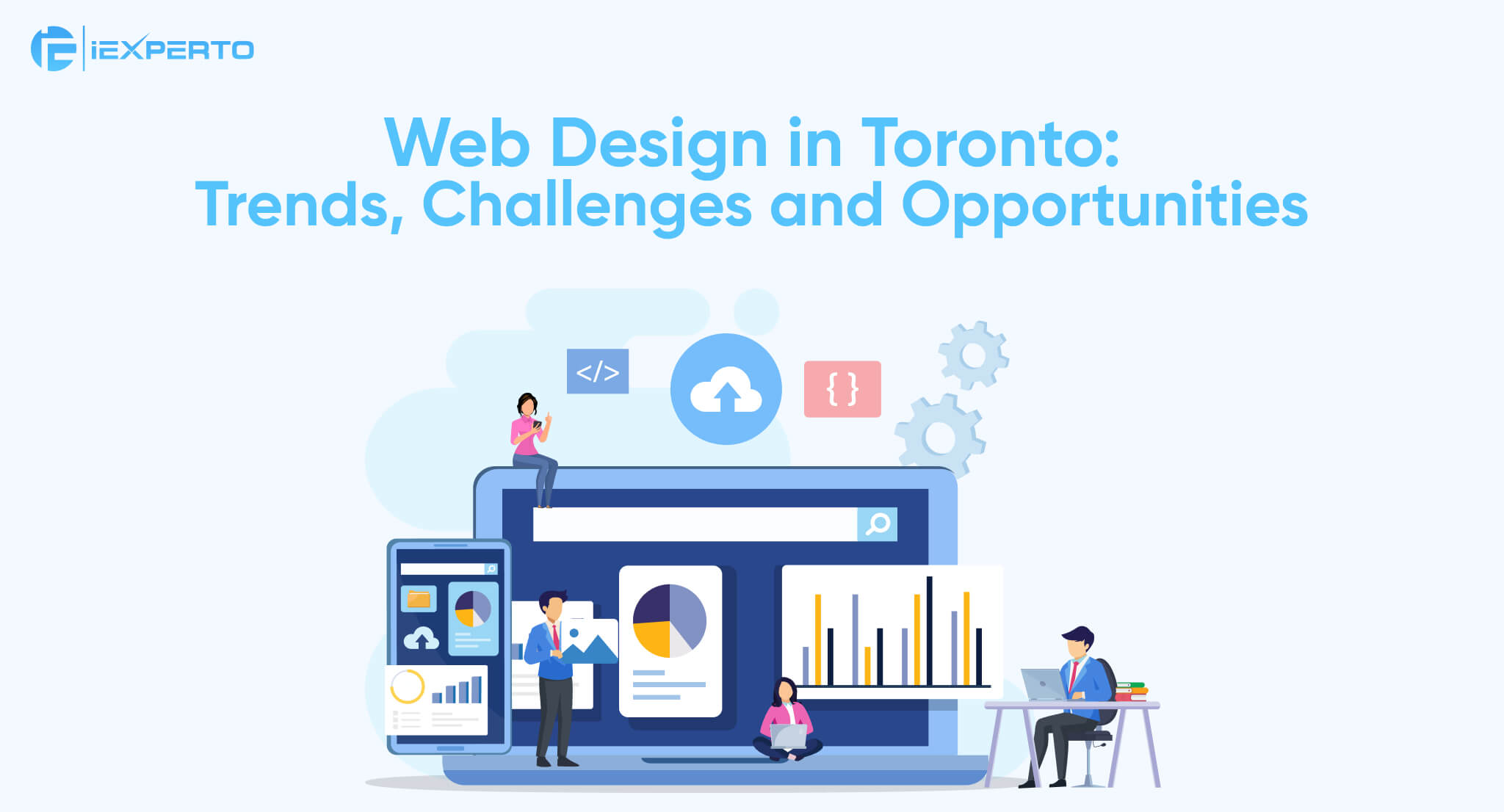
To mark your footsteps in this digital age, web design and development are much-needed factors. It helps to build your online presence, grow your brand’s image, help users perceive your business, and more.
You see, many online tech giants are spending more and more time and effort to make their websites professional and elegant. Only to stay in the competition and make their business expand and thrive.
Let’s talk about one of the rapidly growing digital cities, Toronto. This city is evolving fast, and if you have a business in this city, then you must re-think your website design or upgrade its look to compete in the market.
So if you have a growing company or are thinking of building one in this vibrant Toronto city, look no further; we are here to help and guide you.
In this blog, we’ll explore the importance of web design, trace its evolution in Toronto, identify key trends, challenges, and opportunities, and provide practical tips for selecting and collaborating with a web design agency in Toronto.
Let’s delve into the ins and outs of web design in Toronto!
A short historical perspective of the evolution of Web Design in Toronto
One of the interesting facts about Toronto’s web design history is that web design was far simpler than it is today. They used to focus more on functionality than aesthetics. Websites had a text-heavy design with tables and frames used to structure the information and other structures.
But over the last few decades, the web design industry in Toronto has grown significantly.
Let’s now check out the evolution of web design in Toronto!
Early 1990s: Web design focused on functionality; websites featured text-heavy designs with tables and frames for structuring content.
The early 2000s: a shift towards blending functionality and visual appeal; the emergence of Adobe Flash-based websites with multimedia content; the beginnings of user-centric design in Toronto
The mid-2000s: Arrival of Web 2.0, featuring increased interactivity, user-generated content, and minimalistic design philosophy; focus on visually engaging, easy-to-navigate, and content-rich websites.
Late 2000s onwards: Mobile technology advancements led to the development of responsive web design; Toronto’s design community adapted quickly, maintaining the city’s status as a tech hub.
Today, Web design in Toronto promotes a seamless user experience, interactivity, minimalistic design, navigational simplicity, and mobile responsiveness, with an emphasis on aesthetically appealing, brand-centric visuals.
Why does web design matter in this digital age?
You already know why web design matters in this highly competitive time. Having a well-designed website will help you attract more customers. And more customers mean more profits. In short, it’s a money-making machine for your business.
But the condition is that you have to construct it smartly, either by yourself or through an agency. Therefore, you need to know the in-depth scenarios before planning to design your website.
To help you out, let’s briefly learn why web design matters:
It creates first impressions: When a user visits a website, it gives them their first insight into a company. If it looks odd or messy, then users will not want to stay or browse your website. For instance, a well-designed site conveys professionalism and trustworthiness, making a positive impact on the user’s perception of the brand.
Builds usability: Good web design incorporates user-friendly navigation, an intuitive layout, and easy-to-understand content, which significantly increases the chances of user engagement and repeat visits.
Creates credibility: A well-crafted website lends legitimacy and credibility to a business. If the website looks modern, is easy to navigate, and functions smoothly, it implies that the business is well-established and reliable.
Gives a competitive advantage: In an era where online competition is fierce, having a quality web design can give a business an edge over its competitors and help it stand out in the crowd.
Beneficial for Search Engine Optimization (SEO): A well-optimized website design, with the correct use of headers, keywords, and links, can improve a website’s ranking on search engine results, thereby increasing online visibility and traffic.
Increases accessibility: With a growing reliance on the web for information and transactions, it’s crucial that web designs incorporate features that ensure websites are accessible to all users, including those with disabilities.
Keeps your business consistent: An effective web design ensures consistency of brand image across all web pages, delivering a cohesive and unique brand experience for visitors.
Related read: 10 Signs You Need a Website Redesign
What are the essential web design basics to follow?
However, there are some basics of website design, such as website structure, templates, UI-UX, mobile responsiveness, SEO, and more.
Apart from that, there are still some significant facts about web design that you should know. Such as:
Clarity and simplicity: A messy website can confuse visitors. Plus, it reduces user interaction while increasing the bounce rate of your website. Which is really a bad thing for a website to rank and grow.
Whereas a clean, organized, and simple design helps users find what they’re looking for easily. So this is the first and foremost thing to consider.
Responsiveness: As time flies, users are becoming smarter. And they don’t like to visit a website that loads slowly, especially on a mobile device.
Therefore, it’s essential that your website is responsive and operates seamlessly across all devices – be they mobile, tablet, or desktop.
User-navigation: Ensuring smooth navigation aids the user experience. This can include a well-structured menu, breadcrumbs, or a site map. Plus, you can add some relevant internal linking to help your users find the desired page that they are looking for.
Don’t try to overwhelm your users by using too many illustrations or complex design materials.
Typography: Use fonts that align with your brand, are web-friendly, and enhance readability. Keeping the font consistent across the website is also essential.
Don’t use mixed font styles on your website. And if you think you should change your brand font, you should do it for your entire website, including your social channels.
Color scheme: Choose a color scheme that complements your brand and enhances the user experience. Typically, sticking to a palette of 2-3 primary colors works best.
Visual hierarchy: Using different sizes, colors, and positions, you can guide visitors’ attention toward the most critical elements first. Try to make the best use of your web pages.
It will help users navigate your website and find the content they are looking for.
High-quality images: Good-quality visuals increase engagement rates. Always ensure the pictures and graphics used on your site are crisp and relevant.
Load time: Minimize the website’s load time as much as possible. Users typically wait only a few seconds before leaving a slow-loading website.
SEO practices: Incorporate SEO-friendly practices into your web design to drive higher organic traffic.
These are the basic things that you should keep in mind before you design your website. However, there are a lot more things to do. But we have compiled the basic ones.
Once you find the best shot for your website, you can go for advanced tactics to boost your business’s growth.
Learn why website security is important for your business?
Key challenges faced by Toronto’s Web Designers
It’s a big challenge to encounter different client requirements and issues. Especially for developers, they have to go through a series of negotiations with the clients to make the project successful.
After a long time of meetings and collaboration, something unique and special comes about. Both the client and developers breathe a sigh of relief once it’s done.
So considering these facts, we’ve compiled some common challenges that you should keep in mind before hiring developers or working with an agency.
- Keeping up with evolving trends: Web design is a rapidly evolving industry, with new trends, techniques, and technologies constantly emerging. A significant challenge that web designers face is keeping up with these changes. Most of the time, they are so busy with their project that they can’t find the time for skill development.
- Creating user-centered designs: Designing websites that seamlessly cater to the users’ need. Sometimes it becomes a hectic situation for web designers to understand the client’s concept and vision.
- Responsiveness: As the usage of mobile devices and tablets continues to grow, creating designs that work perfectly across all platforms is increasingly difficult.
- Performance optimization: Ensuring that a website loads quickly and performs well can be a tricky task, given the balance between design elements and performance.
- SEO integration: Designers must consider the SEO basics in their design from the ground up. This means they have to understand the fundamentals of SEO along with the design. So it seems to be a tough thing for them.
- Accessibility: Designing websites that are accessible to all people, including those with disabilities or who are using assistive technologies, is a challenge that shouldn’t be overlooked.
You know the basics of web design and why it’s important. Now we’ll give you some tips on selecting the right web design agency in Toronto.
How to select the right Web Design agency in Toronto
Choosing the right web design company might be critical to your online success. The following are the main factors to consider while choosing a web design agency in Toronto:
- Portfolio of work: Before working with any agency, the first and foremost task is to check their previous projects. After you overview the project, you’ll understand their capabilities, creativity, and technical expertise.
- Client testimonials and reviews: Once you review the portfolio, the next task is to check other customer’s reviews and testimonials. These provide real-life insights into the agency’s reliability, professionalism, and client satisfaction levels.
- Expertise in your industry: The third thing to do is check their years of experience in the related industry. The agency should understand your business and have experience creating websites for your industry.
- Range of services: An agency offering a range of services (like web design, SEO, and digital marketing) can be advantageous for a comprehensive digital strategy.
- Response to your queries: How clear and prompt they are in responding to your questions can give you a sense of their communication skills and customer service.
- Pricing: Ensure you understand their pricing model. Choose an agency that provides excellent value within your budget.
- Maintenance and support: Find out if the agency provides ongoing website maintenance and support post-launch.
- Project deadline: The agency should be able to deliver your project within a realistic timeline.
Remember, choosing the right web design agency isn’t about finding the one with the most awards or the biggest client list; it’s about finding the one that best fits your specific needs and business goals.
Tips for Collaborating with a Toronto Web Design Agency
Working with a web design agency isn’t just about handing over the reins; it involves active collaboration to ensure the best final product.
Here are some key tips for effective collaboration:
Define your goals: Communicate your business objectives, expectations from the website design, target audience, and desired results clearly right from the start.
Be free and open-minded: Respect the expertise of the agency. Be open to their ideas and suggestions.
Regular communication: Schedule ongoing meetings to review progress, provide input, and address any issues or changes as they arise.
Provide timely feedback: Promptly providing clear, concrete, and constructive feedback can help the project stay on track and ensure the agency meets your expectations.
Be responsive: Prompt responses to the agency’s requests can keep the project moving smoothly and within the timeline.
Trust their expertise: The agency has the experience and the skills. Trust them to do what they do best while you focus on your business.
Have a point of contact: Designate a point of contact within your organization for seamless communication with the agency.
Participate actively: Your active participation in the process can ensure that the final output aligns with your vision.
An effective collaboration with your web design agency could be the key to the success of your online presence. Mutual respect, clear communication, and an understanding of roles and responsibilities underpin the development of a productive partnership.
Conclusion
Toronto web design combines a mix of trends, difficulties, and opportunities. Designers must address challenges such as responsiveness, SEO integration, and accessibility. It will help them continue to develop in response to new technology and changing user preferences.
Thankfully, the vibrant city provides great scope for growth and learning. Choosing the right web design company and maintaining a fruitful collaboration can significantly contribute to your digital success.
At iExperto, we believe that the success of your website’s design will be more vital than ever. Plus, collaborating with a vibrant and expert team can also make your web design journey easier.
So make a wise decision and smartly collaborate with your web design partner to make your business flourish and grow.
Also learn: Choose the Best Montreal Web Design Company to Strengthen Your Business Website

